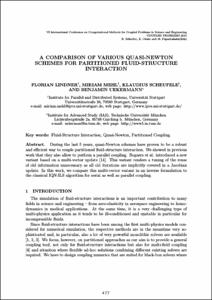Mostra el registre d'ítem simple
A comparison of various quasi-newton schemes for partitioned fluid-structure interaction
| dc.contributor.author | Lindner, Florian |
| dc.contributor.author | Mehl, Miriam |
| dc.contributor.author | Scheufele, Klaudius |
| dc.contributor.author | Uekérmann, Benjamin |
| dc.date.accessioned | 2020-06-19T11:22:00Z |
| dc.date.available | 2020-06-19T11:22:00Z |
| dc.date.issued | 2015 |
| dc.identifier.isbn | 978-84-943928-3-2 |
| dc.identifier.uri | http://hdl.handle.net/2117/191193 |
| dc.description.abstract | During the last 5 years, quasi-Newton schemes have proven to be a robust and efficient way to couple partitioned fluid-structure interaction. We showed in previous work that they also allow to perform a parallel coupling. Bogaers et al. introduced a new variant based on a multi-vector update [14]. This variant renders a tuning of the reuse of old information unnecessary as all old iterations are implicitly covered in a Jacobian update. In this work, we compare this multi-vector variant in an inverse formulation to the classical IQN-ILS algorithm for serial as well as parallel coupling. |
| dc.format.extent | 12 p. |
| dc.language.iso | eng |
| dc.publisher | CIMNE |
| dc.subject | Àrees temàtiques de la UPC::Matemàtiques i estadística::Anàlisi numèrica::Mètodes en elements finits |
| dc.subject.lcsh | Finite element method |
| dc.subject.lcsh | Coupled problems (Complex systems) -- Numerical solutions |
| dc.subject.other | Fluid-Structure Interaction, Quasi-Newton, Partitioned Coupling |
| dc.title | A comparison of various quasi-newton schemes for partitioned fluid-structure interaction |
| dc.type | Conference report |
| dc.subject.lemac | Elements finits, Mètode dels |
| dc.rights.access | Open Access |
| local.citation.contributor | COUPLED VI |
| local.citation.publicationName | COUPLED VI : proceedings of the VI International Conference on Computational Methods for Coupled Problems in Science and Engineering |
| local.citation.startingPage | 477 |
| local.citation.endingPage | 488 |


